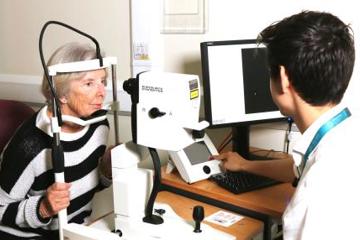A team led by Siegfried Wagner and Pearse Keane of Moorfields Eye Hospital and UCL Institute of Ophthalmology (and spanning UCL institutions) has identified markers that indicate the presence of Parkinson’s disease in patients on average seven years before clinical presentation. This is the first time anyone has shown these findings several years before diagnosis, and these results were made possible by the largest study to date on retinal imaging in Parkinson’s disease.
The study, published today in Neurology®, the medical journal of the American Academy of Neurology, identified markers of Parkinson’s in eye scans with the help of artificial intelligence (AI). Its analysis of the AlzEye dataset was repeated using the wider UK Biobank database (healthy volunteers), which replicated the discoveries. The use of these two large, powerful datasets has enabled the team to identify these subtle markers, even though Parkinson’s disease has a relatively low prevalence (0.1-0.2% of the population). Generation of the AlzEye dataset was enabled by INSIGHT, the world's largest database of retinal images and associated clinical data.
The use of data from eye scans has previously revealed signs of other neurodegenerative conditions, including Alzheimer’s, multiple sclerosis and, most recently, schizophrenia, in an emerging and exciting field of research referred to as “oculomics”.
Doctors have known for a long time that the eye can act as a ‘window’ to the rest of the body, giving a direct insight into many aspects of our health. High-resolution images of the retina are now a routine part of eye care – in particular, a type of 3D scan known as ‘optical coherence tomography’ (OCT), which is widely used in eye clinics and high-street opticians. In less than a minute, an OCT scan produces a cross-section of the retina (the back of the eye) in incredible detail – down to a thousandth of a millimetre.

These images are extremely useful for monitoring eye health, but their value goes much further, as a scan of the retina is the only non-intrusive way to view layers of cells below the skin’s surface. In recent years, researchers have started to use powerful computers to accurately analyse large numbers of OCTs and other eye images, in a fraction of the time it would take a human. Using a type of AI known as ‘machine learning’, computers are now able to uncover hidden information about the whole body from these images alone. Harnessing this new potential is what oculomics is about.
This work has involved collaboration between the NIHR (National Institute of Health and Social Care) Biomedical Research Centres at Moorfields Eye Hospital, University Hospital Birmingham, Great Ormond Street Hospital (GOSH), Oxford University Hospital, University College Hospital London and the UCL Great Ormond Street Institute of Child Health. The scope and quality of the research has been maximised through these exceptional NHS research partnerships.
Alastair Denniston, consultant ophthalmologist at University Hospitals Birmingham, professor at the University of Birmingham and part of NIHR Moorfields BRC said: “This work demonstrates the potential for eye data, harnessed by the technology to pick up signs and changes too subtle for humans to see. We can now detect very early signs of Parkinson’s, opening up new possibilities for treatment.”
Siegfried Wagner, clinical research fellow at Moorfields Eye Hospital, UCL Institute of Ophthalmology researcher and principal investigator for this and several other AlzEye studies, added: “I continue to be amazed by what we can discover through eye scans. While we are not yet ready to predict whether an individual will develop Parkinson’s, we hope that this method could soon become a pre-screening tool for people at risk of disease. Finding signs of a number of diseases before symptoms emerge means that, in the future, people could have the time to make lifestyle changes to prevent some conditions arising, and clinicians could delay the onset and impact of lifechanging neurodegenerative disorders.”
Louisa Wickham, Moorfields’ medical director, explained that “Increasing imaging across a wider population will have a huge impact on public health in the future, and will eventually lead to predictive analysis. OCT scans are more scalable, non-invasive, lower cost and quicker than brain scans for this purpose.”
See the ITV News interviews with Pearse and Siegfried.
Read more about the study using the 'Academic article' link below:
Watch a short video of Siegfried Wagner talking more about the study:
video transcript
21 August 2023